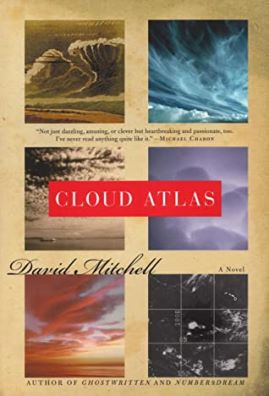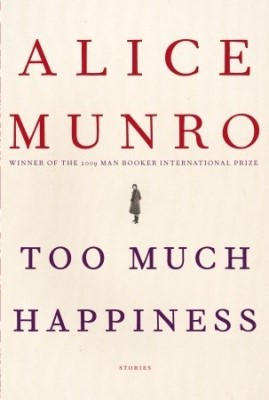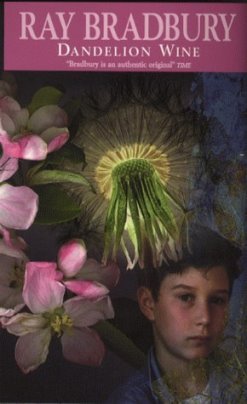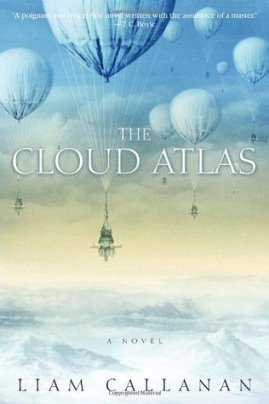Introduction of the ebook: Cloud Atlas
Đánh giá : 4.00 /5 (sao)
A postmodern visionary who is also a master of styles of genres, David Mitchell combines flat-out adventure, a Nabokovian lore of puzzles, a keen eye for character, and a taste for mind-bending philosophical and scientific speculation in the tradition of Umberto Eco, Haruki Murakami, and Philip K. Dick. The result is brilliantly original fiction as profund as it is playful
A postmodern visionary who is also a master of styles of genres, David Mitchell combines flat-out adventure, a Nabokovian lore of puzzles, a keen eye for character, and a taste for mind-bending philosophical and scientific speculation in the tradition of Umberto Eco, Haruki Murakami, and Philip K. Dick. The result is brilliantly original fiction as profund as it is playful. Now in his new novel, David Mitchell explores with daring artistry fundamental questions of reality and identity.
Cloud Atlas begins in 1850 with Adam Ewing, an American notary voyaging from the Chatham Isles to his home in California. Along the way, Ewing is befriended by a physician, Dr. Goose, who begins to treat him for a rare species of brain parasite. . . .
Abruptly, the action jumps to Belgium in 1931, where Robert Frobisher, a disinherited bisexual composer, contrives his way into the household of an infirm maestro who has a beguiling wife and a nubile daughter. . . . From there we jump to the West Coast in the 1970s and a troubled reporter named Luisa Rey, who stumbles upon a web of corporate greed and murder that threatens to claim her life. . . . And onward, with dazzling virtuosity, to an inglorious present-day England; to a Korean superstate of the near future where neocapitalism has run amok; and, finally, to a postapocalyptic Iron Age Hawaii in the last days of history.
But the story doesn’t end even there. The narrative then boomerangs back through centuries and space, returning by the same route, in reverse, to its starting point. Along the way, Mitchell reveals how his disparate characters connect, how their fates intertwine, and how their souls drift across time like clouds across the sky.
As wild as a videogame, as mysterious as a Zen koan, Cloud Atlas is an unforgettable tour de force that, like its incomparable author, has transcended its cult classic status to become a worldwide phenomenon. …more
Review ebook Cloud Atlas
This book proves David Mitchell can be any writer he chooses. The six novellas that comprise Cloud Atlas are forgeries – and they are original. Each adopts the voice of a distinct author. The whole is greater than the sum of its parts, but all of the parts are superb. It is a sextet, like the one found within the novel, with piano, clarinet, cello, flute, oboe, and violin – every individual instrument pleasing, but when played altogether becomes something different and brilliant – the Cloud Atl
This book proves David Mitchell can be any writer he chooses. The six novellas that comprise Cloud Atlas are forgeries – and they are original. Each adopts the voice of a distinct author. The whole is greater than the sum of its parts, but all of the parts are superb. It is a sextet, like the one found within the novel, with piano, clarinet, cello, flute, oboe, and violin – every individual instrument pleasing, but when played altogether becomes something different and brilliant – the Cloud Atlas Sextet.
Each novella is broken, torn in two, or interrupted, and later continued after the sixth, which is the only one completed in one section. Then the previous five stories are concluded in descending order.
1. THE PACIFIC JOURNAL OF ADAM EWING
Written as a journal. The first story is a delightful combination of Melville, Defoe, and James Fenimore Cooper. It has the serious tone and charm of 18th and 19th century literature, but goes a bit too far, just short of mockery. It is not parody, nor disrespectful. Somehow it has a layer of – what? invisible mirth?
The acknowledgments notes Michael King’s definitive work on the Moriori, A Land Apart: The Chatham Islands Of New Zealand which provided Mitchell with a factual account of Chatham Islands history. This part of the story is interesting, and adds historical details essential to the plot in the way Moby Dick does with whaling information.
Moriori, 1877, survivors of the 1835 Maori invasion
2. LETTERS FROM ZEDELGHEM
Letters, one way. Robert Frobisher, writes amusing accounts of his escapades in Belgium to his lover Rufus Sixsmith while he works for a famous composer as an amanuensis. I pictured Frobisher to be like a young Hugh Laurie. There is something of Waugh, or Nancy Mitford in style and humour. He finds the Adam Ewing journal.
The acknowledgments notes “certain scenes in Robert Frobisher’s letters owe debts of inspiration to Delius as I Knew Him by Eric Fenby….The character Vyvyan Ayrs quotes Nietzsche more freely than he admits.” And like Nietzsche, Ayrs has tertiary syphilis, “The syphilitic decays in increments, like fruit rotting in orchard verges”.
“Eric William Fenby, OBE (22 April 1906 – 18 February 1997) was an English composer and teacher who is best known for being Frederick Delius’s amanuensis from 1928 to 1934. He helped Delius realise a number of works that would not otherwise have been forthcoming…In 1928, hearing that Delius had become virtually helpless because of blindness and paralysis due to syphilis, he offered to serve him as an amanuensis.” – Wikipedia
“Delius, Delius amat, Syphilus, Deus, Genius, ooh”. – Kate Bush
The amanuensis Eric William Fenby
3. HALF-LIVES, THE FIRST LUISA REY MYSTERY
It’s terrible! in a good way. A classic thriller/mystery/crime novel. Cheesy style and plot: spunky girl reporter, whose father (Lester Rey, now dead) had been a cop fighting corruption. Several highly improbable escapes from certain death. All the clichés of this genre are here and brilliantly strung together. Rufus Sixsmith, the addressee in the previous episode, is a key character and his letters from Zedelghem are discovered after he is murdered. Does Sixsmith’s prediction about the nuclear reactor come true?
Lester del Rey
4. THE GHASTLY ORDEAL OF TIMOTHY CAVENDISH
The memoir of a sixty something publishing agent, trapped in an old folks home. Cavendish is like an acid-tongued old geezer Randle McMurphy, battling another Nurse Ratched – but as written by Martin Amis. He reads the manuscript for Half-Lives, intending to publish it, as well as his own memoir, “I shall find a hungry ghostwriter to turn these notes you’ve been reading into a film script of my own.”
Nursey
5. AN ORISON OF SONMI~451
Written in Q & A form; sci-fi; a dystopian future, the economy dependent on slave clones. The clone Sonmi becomes the first stable, ascended fabricant, i.e., fully human. Some plot elements of Bladerunner.
Sonmi later watches the film (“disneys”) The Ghastly Ordeal of Timothy Cavendish, “one of the greatest movies ever made by any director, from any age.” Ray “451” Bradbury, Orwell, Huxley and Plato’s Republic are referred to. Somni is Winston Smith – and she is Jesus.
Doona Bae as Sonmi
6. SLOOSHA’S CROSSIN’ AN’ EV’RYTHIN’ AFTER
Futurist speculative fiction – civilization has fallen, the few remaining people live a basic existence. Sort of a Tolkienian fantasy but Mitchell’s marvelous invented dialect is Burgessish. Zachry the goatherder – there and back again – is a Valleysman on Big I, Ha-Why. “Valleysmen only had one god an’ her name it was Sonmi”.
Zachry sees a recording of Sonmi’s Q & A interview, because there is a small group of advanced survivors, “Prescients,” and one arrives on a great ship to live on the island, to learn the ways of these primitive people. They have a Prime Directive – but who ever follows those? They are nonbelievers,
We Prescients, she answered, after a beat, b’lief when you die you die an there ain’t no comin back.
But what ’bout your soul? I asked.
Prescients don’t b’lief souls exist.
But ain’t dyin’ terrorsome cold if there ain’t nothin’ after?
Yay—she sort o’ laughed but not smilin’, nay— our truth is terror-some cold.
Jus’ that once I sorried for her. Souls cross the skies o’ time, Abbess’d say, like clouds crossin’ skies o’ the world. Sonmi’s the east’n’west, Sonmi’s the map an’ the edges o’ the map an’ b’yonder the edges.
Mauna Kea Observatories on “Big I, Ha-Why”.
The stories are connected by certain reoccurring themes and events. Truth. Time. Betrayal. Drugs. Poison. Power. Captivity. Masters and Slaves. Freedom. Cruelty. Worship. The Number Twelve, Seven. Worms, Snakes, Ants, Souls. Birthmarks. Escape. Letters. Books. Music. Films. Aging. Corporate Society. Religion. And there are many literary allusions: Moby Dick; The Bible; Don Juan; Time’s Arrow; To the Lighthouse; The Gulag Archipelago; An Evil Cradling; Nineteen Eighty-four; Fahrenheit 451; All Quiet on the Western Front . Nietzsche, Kipling, Conrad, Zane Grey, Homer. Harry Harrison. And more.
One Novella is slyly presented within another. I found myself clinging to the first narrative as the “real” one. When it turns up as “a curious dismembered volume” in the second, damn! I swallowed hard and justified such an appearance as quite possible. Then it is merely mentioned in a manuscript – the third novella – which is being read in the fourth. Got that? making it entirely illogical to continue my belief. And worse: Frobisher says, “Something shifty about the journal’s authenticity—seems too structured for a genuine diary, and its language doesn’t ring quite true—but who would bother forging such a journal, and why?”
So I’m forced into using doublethink of the highest order. The fact is, you want each of these narratives to be the real one. They are that good. The structure weakens the reader’s fantasy that this is “real”. It becomes very awkward, like explaining a time travel paradox.
Still…never underestimate the power of doublethink. Autua, Adam Ewing, Robert Frobisher, Rufus Sixsmith, Timothy Cavendish, Sonmi, Zachry, Meronym, all remain with me…
*Sob*.
…more


 Đang tải dữ liệu
Đang tải dữ liệu









Chia sẻ ý kiến của bạn